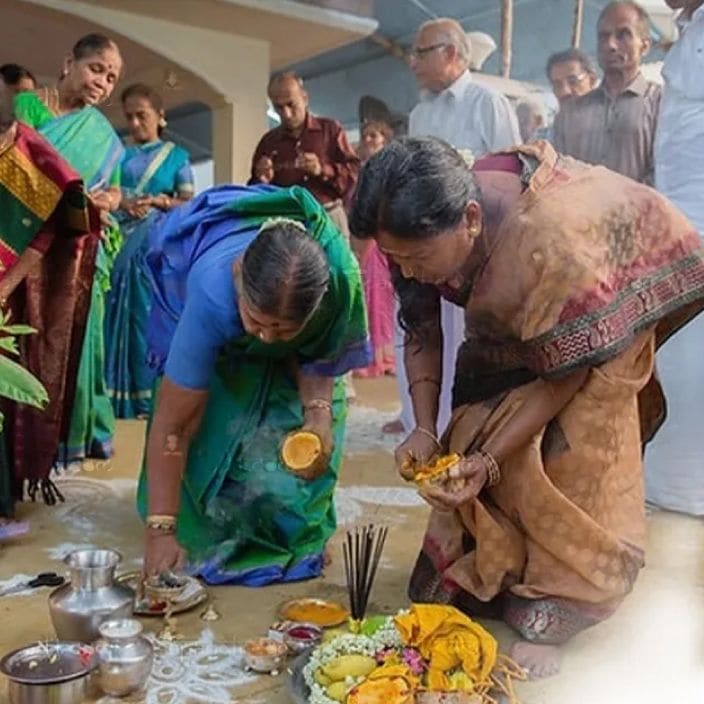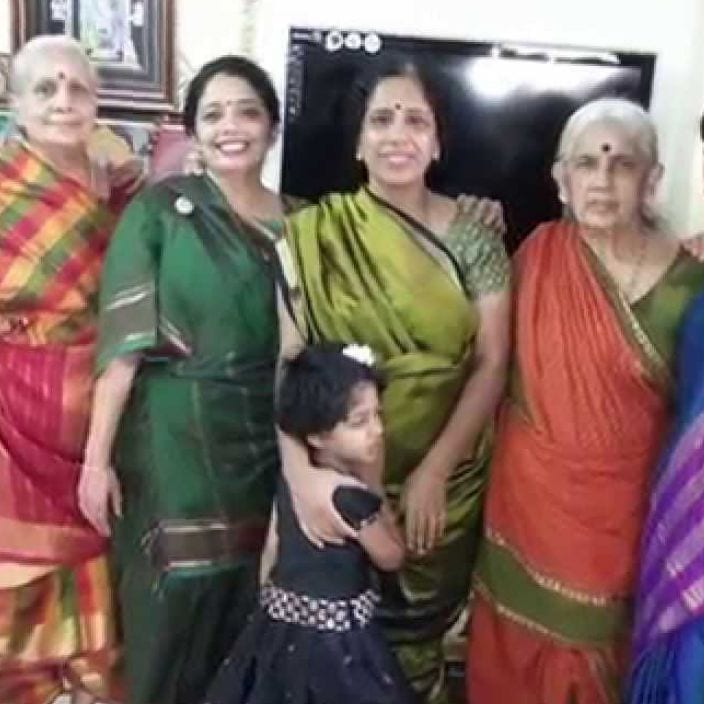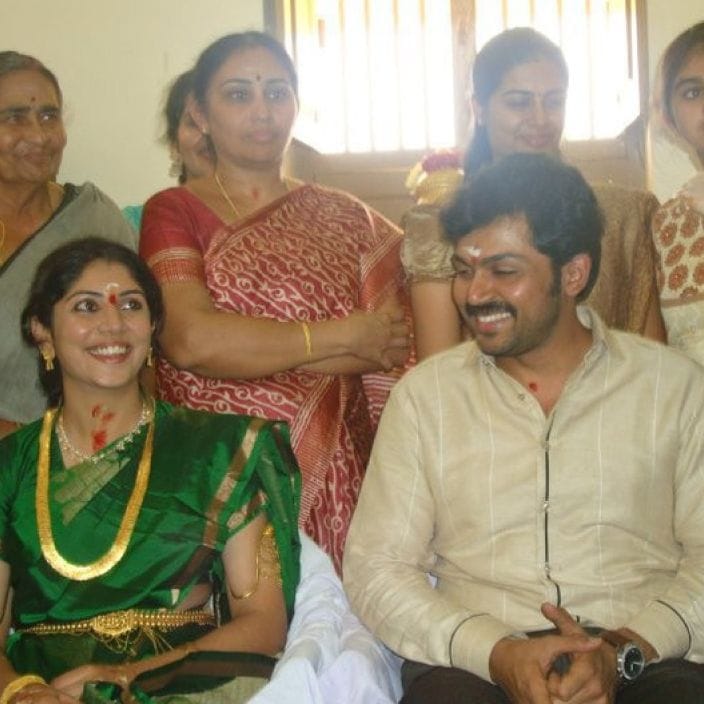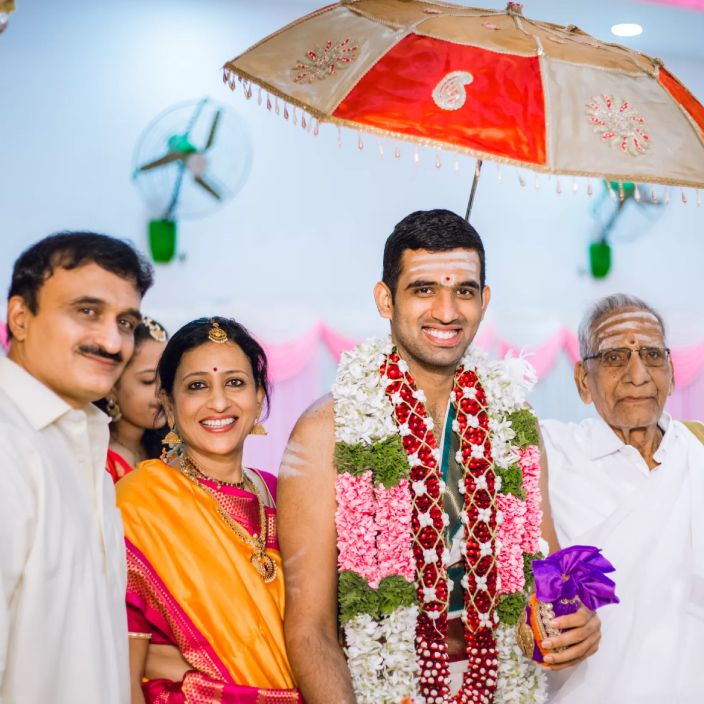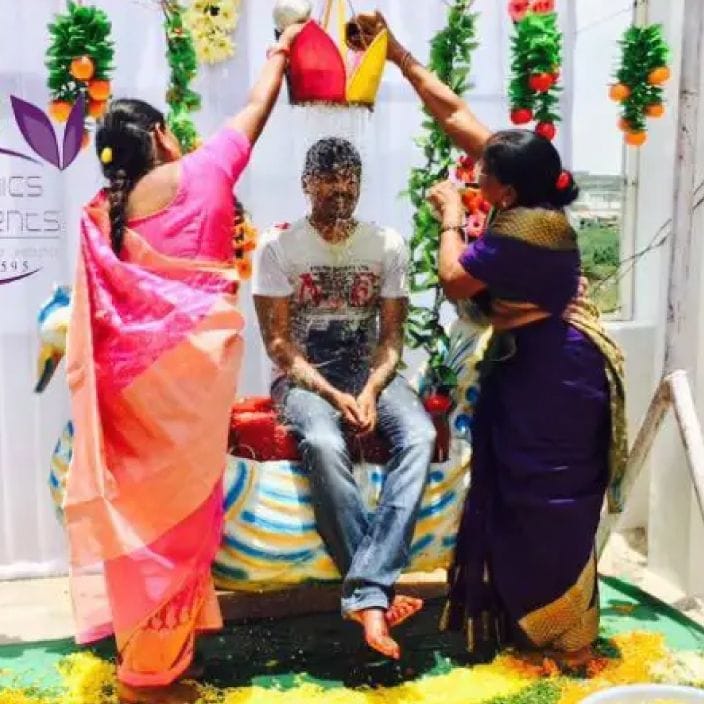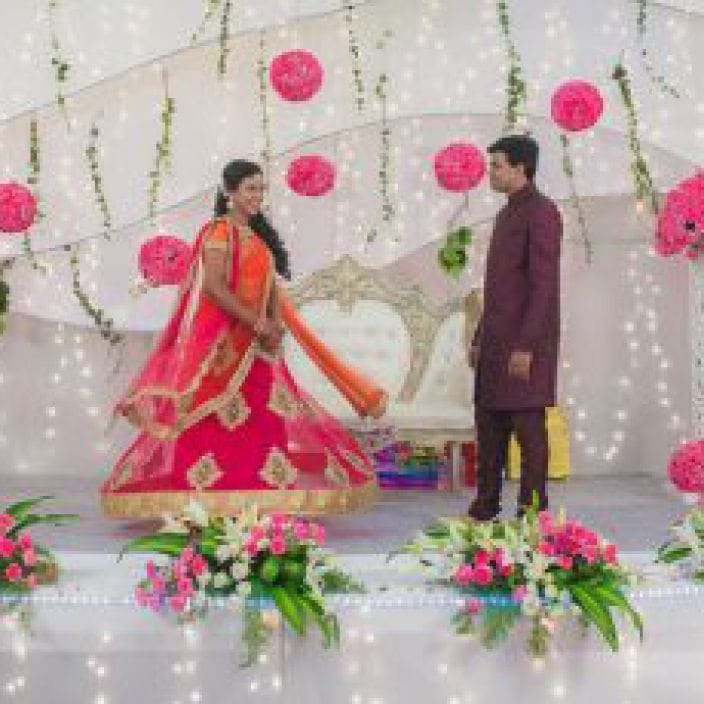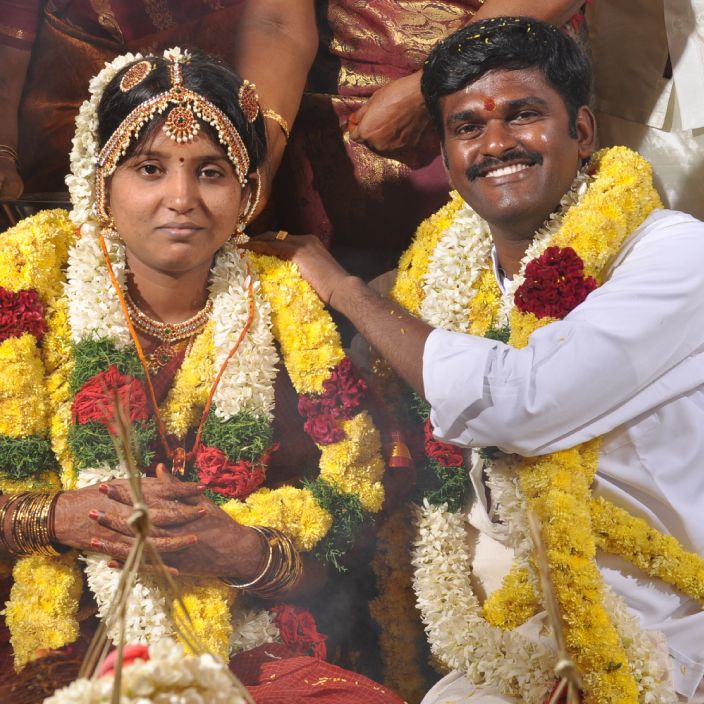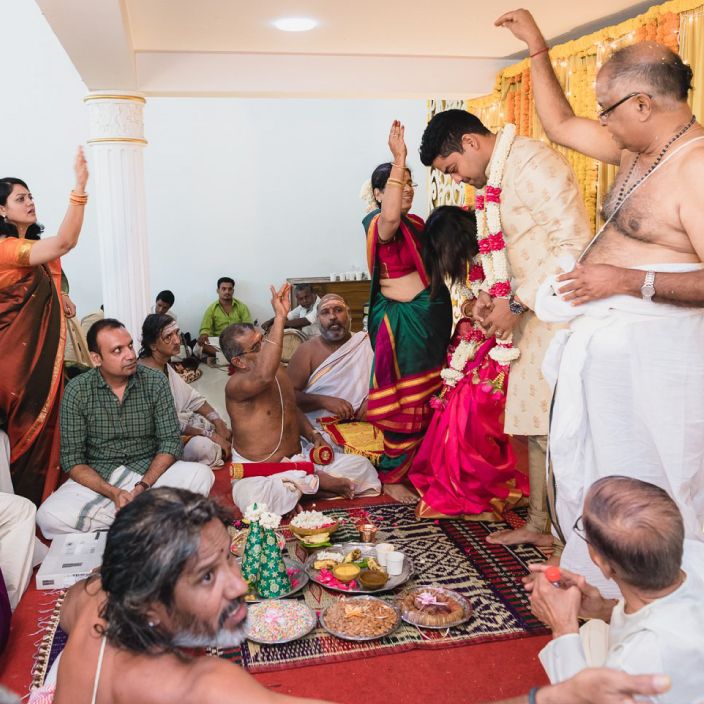For best prices and early deliveries, WhatsApp us at. 918488070070
Tamil Nadu/ Puducherry
Tamil Nadu is a large coastal state in South India with a neighbouring Union Territory of Puducherry, formally known as Pondicherry. Tamil Nadu is famous for its Dravidian-style temples, diverse cuisine, beautiful sarees, and so much more. Puducherry has long been known for its French Colonial architecture, quaint cafes, and serene beaches. While there are communities of Christians, Muslims, and Jains in these areas, a majority of the population follows Hinduism. Thus, most Tamil weddings have a series of rituals and traditions that follow the Hindu faith. The wedding rituals vary slightly across different Tamil communities, such as Chettiars, Brahmins, and Iyengars, but they generally follow the processes set down in the Vedic scriptures.
Tracing the Traditions
Tamil weddings start with a series of pre-wedding rituals that happen as a lead-up to the main wedding. The journey to marriage begins with the Lagna Pathirikai ceremony to assess the compatibility of the couple by matching their horoscopes. This is followed by the Panda Kaal Muhurtam, where a bamboo pole is erected at the homes of the bride and groom, symbolising stability. Another popular pre-wedding ceremony is the Sumangali Prarthanai ceremony, which involves prayers where married women bless the bride.
The engagement ceremony, known as Nishchayathram, is an agreement to marriage. During this occasion, families exchange gifts, and elders bless the couple. This event reinforces the bride and groom’s commitment towards their marriage. It is often followed by Pallikal Thellichal, where the wedding venue is cleansed. This pre-wedding ritual is a symbolic gesture of hope for the couple's future. Another significant tradition, known as Naandi Shrardham or Naandi Shradh, is observed to seek blessings from ancestors for a prosperous marriage. Another important pre-wedding custom practised in Tamil Hindu weddings is the Vrutham ceremony. During the ritual, a yellow thread soaked in turmeric is tied around the wrists of both the bride and groom. The families arrange for clay pots decorated with turmeric and sandalwood paste. These pots are then filled with nine types of grains called Navadhaanyam, along with some curd. These ingredients symbolise seeds of prosperity that will be sown in their lives.
Many Tamil weddings borrow ceremonies that are more common in North India, such as the Mehendi and Sangeet. During the Mehendi ceremony, the bride, her female relatives, and friends come together and get henna designs on her hands and feet. The bridal mehendi designs often carry symbols of love, joy, and fertility. The Sangeet ceremony is an occasion for the couple filled with music, dance, and laughter as their families and friends join together to perform dances.
On the day of the wedding, the bride and groom start their day with a bath known as Mangala Snanam to purify themselves before tying the knot. The groom is then warmly welcomed by the bride’s family upon his arrival at the wedding venue. The bride’s mother performs a ritual called Aalathi. In this, she offers honey and yoghurt to the groom.
After being escorted to the wedding mandap, the priest conducts ceremonies to sanctify the surroundings. Amidst all the rituals, there is a heartwarming tradition called Kashi Yatra, where the groom humorously pretends to leave for Kashi (Varanasi) to become a monk, only to be persuaded back by the bride’s father to marry his daughter. In another ceremony called Maalai Maatral, the couple exchanges flower garlands, symbolising their commitment.
During the Oonjal ceremony, they sit on a decorated swing while being serenaded by family members with songs and blessings. The elders symbolically wash their feet wishing them a life together while embodying Radha and Krishna. An emotional moment unfolds during Kanyadaanam when the father of the bride formally gives her hand in marriage. In this wedding ceremony, the bride offers her hand to the groom symbolising her acceptance of his responsibility.
Following this is the Mangalsutra Dharanam ritual, where the groom places a necklace called Thali or mangalsutra around the bride’s neck to signify her status. The Saptapadi ceremony involves the couple taking seven rounds around a fire, each round representing a vow they make in front of Agni, the fire god. The wedding concludes with the Sindoor Daan tradition, where the groom applies sindoor (vermillion) on the bride’s hair parting.
After the ceremony is over and the couple is married, the family hosts a lunch for the friends and family. Once all wedding rituals are completed, the newlyweds head home. The Grihapravesham ceremony marks the bride's entry into her household with rituals and blessings signifying prosperity and happiness. The Maruvidu Varudal tradition entails the bride returning to her parent's house for a day or two post-wedding to show respect for her bond with her family.
Valeyadal, and Gauri Puja are part of the Tamil wedding traditions as well and are crucial to the auspiciousness and cultural significance of the wedding.
Wedding Attire
In Tamil Nadu and Puducherry weddings, traditional attire and jewellery play a role in showcasing the heritage of the region. The bride typically adorns herself in a Kanchipuram saree (Kanjeevaram sarees) well known for its silk material and intricate zari work. These sarees boast a legacy of over 400 years, each piece taking around 10 days to craft. The vibrant hues and intricate patterns of these sarees represent gracefulness and heritage. Brides often choose sarees in shades like red, maroon, and gold, as these colours are believed to bring good fortune.
As for the groom’s attire, it typically consists of a veshti, a traditional dhoti, paired with an angavastram or a shawl cloth. The traditional veshti is typically white or cream in colour with a gold border, symbolising purity and prosperity. Along with the veshti, the groom may opt for a silk shirt or kurta to complement the attire. This garment has a history dating back to times and has remained a staple in the wardrobes of South Indian men for generations, embodying simplicity and cultural heritage.
The bride embellishes herself with an array of temple jewellery pieces that carry deep cultural and religious meanings. Among these are adornments like the Maang Tikka, which graces the bride's forehead and is actually a symbol of wisdom and insight through its representation of the eye. Additionally, large and intricate Jhumkas earrings are typical in South Indian bridal tradition. She also wears layers of gold necklaces, often featuring designs inspired by Tamil temples. Accessories like Vanki, an armlet worn on the arm, and Ottiyanam, a waist belt, also add a touch of grandeur to her ensemble.
Temple jewellery stands out for its craftsmanship inspired by temple architecture and deities. Treasured pieces such as Kasumala (a necklace made from coins), Salvai (a draped shawl), Oddiyanam (a traditional waist belt), Palakka Mothiram, and Nagapada Thali are known for their details as well as their symbolic significance. Besides these pieces, contemporary jewellery like diamond necklaces and designer earrings have also found their place among the bride’s accessories. The bride's look is often complemented by the iconic Jadai Nagam, a traditional hair ornament symbolizing prosperity and divine protection.
Traditional Cuisine
Tamil weddings are renowned for their lavish feasts that highlight the region's culinary legacy. Guests are served a variety of delicious appetisers such as vadai, bonda, and sundal. The customary wedding feast is typically served on banana leaves. Popular dishes include boiled rice, Sambar, a vegetable stew made with lentils and tamarind and Rasam, a light soup. The meal also features lentils, vegetables and various curry dishes like Kootu, Poriyal (including options like muttakos poriyal), and Avial paired with rice. Additionally, guests may enjoy Biryani—a rice dish cooked with spices and either meat or vegetables—and sides like vazhakkai bajji and crispy appalam.
For dessert, weddings in Tamil Nadu and Puducherry regions must have Payasam—a rice delicacy flavoured with cardamom and nuts—among other sweet treats like caramel payasam and kesari. Other crowd favourites are Mysore Pak, a sweet prepared with gram flour, sugar and ghee and Jangiri, a syrupy delicacy made from urad dal batter. Guests are served local beverages such as neer more (buttermilk), tender coconut water and filter coffee. The meal concludes traditionally with a ripe banana, adding a symbolic touch to this grand culinary experience.
Cultural Decor
The wedding decorations in these areas are meticulously crafted to reflect their heritage; every aspect, from the entrance to the mandap, exudes an aura of sanctity and happiness. The entrance is often adorned with kolam patterns created using rice flour, which are delicately drawn on the ground for their appeal and as symbols of good fortune. Additionally, banana leaves and mango leaves are utilised to craft garlands and backdrops. Various flowers like jasmine, marigold and roses are skillfully strung together to form torans, bouquets and wall adornments.
In Tamil Nadu there is a tradition of arts and crafts that are often incorporated into wedding decorations to add an essence. Tanjore paintings, renowned for their colours and detailed artistry, are a favoured choice for wedding cards and invitations. The use of Kalamkari textiles adds a touch to the decor with their hand-painted or block-printed designs. Whether used as drapes or table runners or integrated into mandap decorations, these elegant textiles bring a flair to the surroundings.
Bronze sculptures also hold significance in Tamil Nadu’s decor theme. These sculptures typically depict deities or mythological figures and are strategically positioned throughout the venue to create an ambience.
The exceptional craftsmanship showcased in these sculptures reflects the region’s heritage while imparting a timeless allure to the wedding decor. During ceremonies, brass oil lamps known as kuthu vilakku are ceremoniously lit to symbolise luck.
Coimbatore is famous for its dhurries and handcrafted floor rugs, which are made from cotton, wool, jute, or silk in an array of colours and designs. These dhurries serve as floor coverings, offering both comfort and visual appeal to guests. They complement the local Athangudi tiles, known for their bright hues and intricate designs.
The pathways leading to the mandap are often adorned with terracotta sculptures from Puducherry, which showcase craftsmanship and add charm to the surroundings. Alongside these elements, contemporary touches are integrated to blend the classic with the modern. Modern lighting fixtures, like fairy lights and LED lanterns, illuminate the venue and are artfully arranged around the mandap or along pathways.
